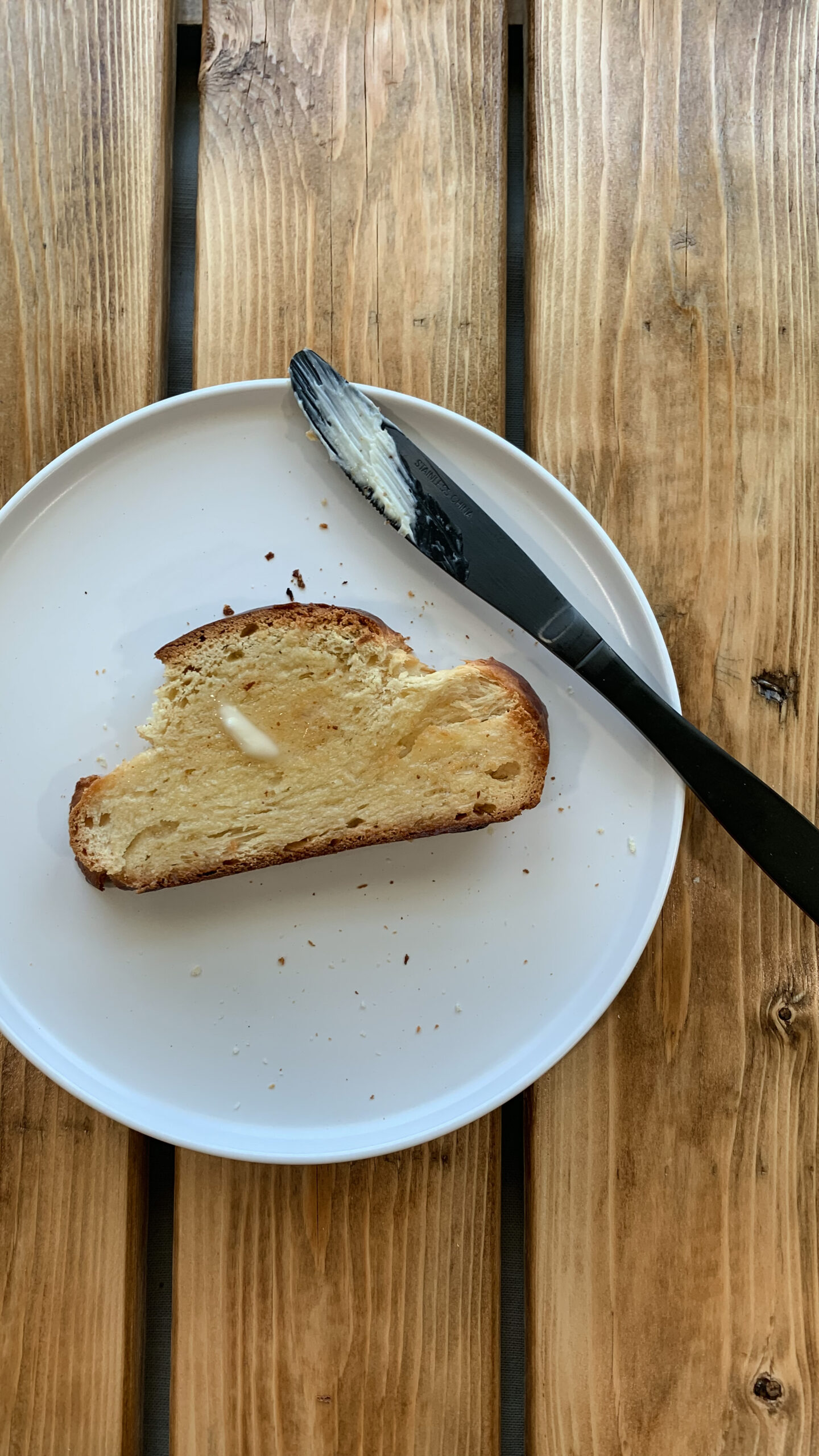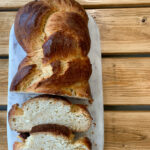Tsoureki (Greek Easter Bread)

Buttery and flakey, this Greek Easter bread is a must try for any occasion! In addition to this bread being so tender and soft, it is incredibly versatile. Tsoureki can be used to make sandwiches, French toast, bread pudding, or even simply toasted with butter and jam. This recipe is so special to me because it is my Papou’s (grandpa) recipe and I make this bread multiple times a year using my grandparent’s Kitchen Aid mixer that they have had since the 60s. I have so many memories of waking up to the sound of the mixer running because my Papou was up early making Tsoureki.
During Easter time, Greeks make this bread to symbolize the resurrection of Christ. The bread is a new creation rising to life just as Jesus Christ has risen from the dead. The three pieces of dough are braided together representing the Holy Trinity. In many cases, you will find this bread with a bright red egg baked into the loaf. Tsoureki contains traditional Greek ingredients such as, Ouzo, Metaxa, and mastiha to give it that classic flavor.
Key Ingredients:
Ouzo: The national spirit of Greece, Ouzo, is a dry anise flavored liqueur made from grapes. Ouzo has a very strong flavor and scent and is typically sipped. You can find Ouzo at your local liquor store or you can use another anise flavored liqueur.
Metaxa: Made with various types of grapes, Metaxa is a Greek cognac that is fruity and spicy. Like Ouzo, many will sip Metaxa and it can be found at local liquor stores, as well. If you can’t find Metaxa, you can substitute your favorite cognac.
Mastiha: Mastiha is a gum harvested from the mastic tree. It is known for it’s helpful digestive properties and is commonly used is Greek baking. It can also be found in oral hygiene and skin care products. The flavor of mastiha is often described as earthy, pine-like, as well as licorice tasting. You can find mastiha at a local Greek food store or online. Be sure to crush the mastiha into a fine powder using a mortar and pestle, meat mallet, or rolling pin.
Comment below if you have ever tried Ouzo, Metaxa, or mastiha!
Tsoureki
Ingredients
- 2 cups milk warm
- 4 packets active dry yeast about 3 tbsps
- 3 sticks unsalted butter melted
- 2 ½ cups sugar
- 7 eggs 6 for the dough + 1 for egg wash
- 1 tbsp mastiha finely crushed
- 1 shot ouzo 1 ounce
- 1 shot metaxa 1 ounce
- 8-10 cups flour
- 1 tsp salt
- sliced almonds optional
Instructions
- BLOOM THE YEAST: Heat milk in a pot on the stove until it is just warm (It should be body temperature or baby-bottle warm). Mix in the yeast and set aside for about 10 minutes while the yeast blooms. *Be careful not to heat the milk too much or it will kill the yeast. If necessary, let the milk cool for a few minutes before adding the yeast.
- MAKE THE DOUGH: In a mixer, add the milk/yeast mixture, sugar, and eggs. Beat until well combined. Add the butter, ouzo, and metaxa to the mixer and combine on a low speed. *Be sure the butter is cooled, so the eggs do not scramble.
- With the mixer on a low speed, add about a cup of flour at a time until the dough is formed, scraping down the sides of the bowl periodically to ensure it is thoroughly mixed. You will know to stop adding flour when the dough is slightly tacky (not sticky) and it is pulling away from the sides of the bowl. Add the salt and mastiha to the dough and mix until combined.
- KNEAD THE DOUGH: Set the mixer to a low-medium speed and knead the dough for about 5 minutes. At this point, the dough may look like it needs more flour, but do not add any more.
- PROVE THE DOUGH: When the dough has kneaded, transfer it to a large, clean bowl, then cover the bowl with plastic wrap and a clean kitchen towel. Set the bowl somewhere warm to rise until the dough has doubled in size.
- SHAPE THE LOAVES: Once the dough has doubled in size, dust your surface with a little flour, dump the dough out, and then knead it by hand for a minute. Divide the dough in half and set one half aside. Divide the remaining dough into three equal parts. Roll each of the three parts into a long, skinny log and place them all parallel to each other. Starting in the middle of the logs, begin to braid them together the same way you would braid hair. Once you have reached the end of one side, pinch those ends together and continue braiding the other side making sure to pinch the ends when you are finished. Place the finished braided loaf on a sheet pan lined with parchment paper. Repeat these steps for the other half of dough.
- PROVE THE DOUGH (AGAIN): Cover the loaves with plastic wrap and a clean kitchen towel again. Set the loaves somewhere warm to rise until it has doubled in size.
- BAKE THE DOUGH: Preheat the oven to 325°F. Beat the remaining egg with a splash of water or ouzo. Uncover the loaves and brush the egg wash all over each loaf. Sprinkle the almonds over the dough, if you are using any. Bake for 45-60 minutes or until the bread is golden brown and a toothpick comes out clean. Let bread cool completely before serving.
Notes
Follow me!
INSTAGRAM: https://www.instagram.com/thegreekgalley/?igshid=YmMyMTA2MY%3D
TIKTOK: https://www.tiktok.com/@thegreekgalley?lang=en
PINTEREST: https://www.pinterest.com/thegreekgalley/
